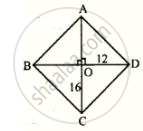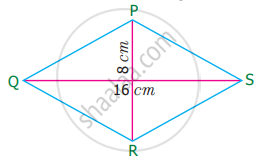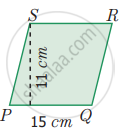Advertisements
Advertisements
Question
The length of the diagonals of a rhombus is in ratio 4 : 3. If its area is 384 cm2, find its side.
Solution
Let the lengths of the diagonals of a rhombus are 4x, 3x.
∴ Area of the rhombus = `1/2 xx ("Product of its diagonals")`
= `1/2 (4x xx 3x) = 384` (given)
⇒ `6x^2 = 384 ⇒ x^2 = 64`
⇒ x = 8 cm

∴ Diagonals are `4 xx 8 = 32` cm and `3(8) = 24` cm.
∴ OC = 16 cm and OD = 12 cm
∴ Side DC = `sqrt("OC"^2 + "OD"^2)`
∴ Side DC = `sqrt(16^2 + 12^2)` [By Pythagoras Theorem in ΔDOC]
= `sqrt(256 + 144) = sqrt(400) = 20` cm
Hence , side of the rhombus = 20 cm.
APPEARS IN
RELATED QUESTIONS
Lengths of the diagonals of a rhombus are 15 cm and 24 cm, find its area.
The area of a rhombus is equal to the area of a triangle. If the base ∆ is 24 cm, its corresponding altitude is 16 cm and one of the diagonals of the rhombus is 19.2 cm. Find its other diagonal.
Find the area of rhombus PQRS shown in the following figure.
Find the area of rhombus PQRS shown in the following figure.
The area of the rhombus when both diagonals measuring 8 cm is
The area of the rhombus is 128 sq.cm and the length of one diagonal is 32 cm. The length of the other diagonal is
The angle between the diagonals of a rhombus is
A man has to build a rhombus shaped swimming pool. One of the diagonal is 13 m and the other is twice the first one. Then find the area of the swimming pool and also find the cost of cementing the floor at the rate of ₹ 15 per sq.cm
The figure ABCD is a quadrilateral in which AB = CD and BC = AD. Its area is ______.

Area of a quadrilateral ABCD is 20 cm2 and perpendiculars on BD from opposite vertices are 1 cm and 1.5 cm. The length of BD is ______.
